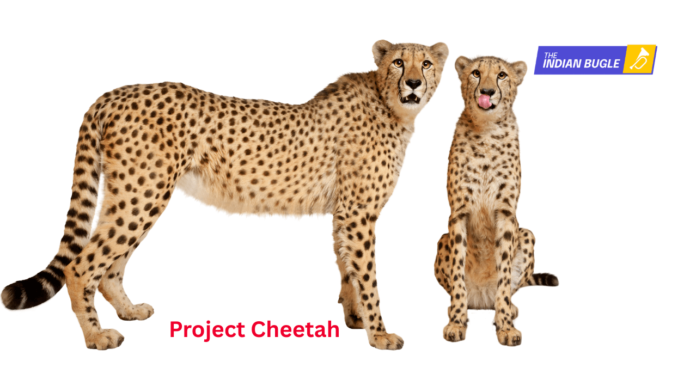In a time when biodiversity faces unprecedented threats, a quiet yet powerful revolution in conservation is unfolding — the translocation and reintroduction of species that had once vanished from their native habitats. By moving animals from thriving populations to regions where they disappeared, conservationists are not only reviving species but also restoring entire ecosystems.
India’s ambitious Project Cheetah is a prime example, but it is far from the only story of animals returning home. Around the world, similar efforts have breathed new life into forests, grasslands, and wetlands — proving that extinction does not always have to be forever.
Project Cheetah – India’s Leap of Faith
The cheetah, once widespread in India, was declared extinct in 1952 due to hunting and habitat loss. In 2022, India launched Project Cheetah, introducing African cheetahs into Kuno National Park in Madhya Pradesh. Twenty individuals were flown in from Namibia and South Africa, making it the first intercontinental translocation of a large carnivore.
The project has faced hurdles — including mortality concerns, ecological debates, and questions of adaptability — yet it stands as a bold experiment. More than just an attempt to restore a lost species, it represents India’s determination to reclaim an important piece of its ecological heritage.
Global Reintroduction Success Stories
Gray Wolves – Yellowstone National Park, USA
- Locally extinct: 1920s, mainly due to hunting.
- Reintroduced from Canada in 1995.
- Impact: Wolves reshaped Yellowstone’s ecology by keeping elk numbers in check. This allowed vegetation to recover, riversides to stabilize, and other species such as beavers and songbirds to thrive — a celebrated case of ecological rebalancing.
European Bison – Forests of Eastern Europe
- Extinct in the wild: Early 20th century.
- Reintroduced from: Captive breeding herds.
- Impact: Now numbering more than 7,000, European bison roam freely across Poland, Belarus, Romania, and other regions. Their return has revived Europe’s last great grazer and enriched forest ecosystems.
Tigers – Sariska and Panna, India
- Locally extinct: Sariska (2004) and Panna (2009) due to poaching.
- Reintroduced from: Other tiger reserves in India.
- Impact: Populations are once again growing in both parks, highlighting India’s success in internal translocation and species recovery.
Black Rhinos – Akagera National Park, Rwanda
- Locally extinct: 2007 after severe poaching.
- Reintroduced from: South Africa in 2017.
- Impact: Black rhinos now live under strict protection in Akagera, boosting eco-tourism and inspiring confidence in Rwanda’s conservation strategy.
Kakapo – New Zealand’s Nocturnal Parrot
- Critically endangered: Fewer than 50 left in the 1990s.
- Reintroduced to: Predator-free offshore islands.
- Impact: With intensive management, including artificial insemination and 24/7 monitoring, the population has now grown to over 250, making the kakapo one of the world’s most closely managed conservation success stories.
Why These Efforts Matter
- Ecosystem restoration: Predators regulate prey, herbivores shape vegetation, and balance returns to entire landscapes.
- Cultural and spiritual revival: Many species hold deep symbolic meaning for communities.
- Biodiversity resilience: Healthier ecosystems are better equipped to withstand climate change.
- Economic benefits: Reintroductions often fuel eco-tourism, providing local communities with sustainable livelihoods.
The Challenges Ahead
Reintroducing species is never without risk.
- Genetic adaptation: Imported populations may not thrive in new conditions.
- Conflict with people: Coexistence strategies are essential where predators or large herbivores return.
- Mortality during translocation: Stress, disease, and accidents are common risks.
- Ecological fit: Habitats must be assessed carefully to ensure long-term survival.
India’s Project Cheetah illustrates these concerns, with debates over habitat suitability and community involvement. The project emphasizes that science, ecology, and people must all be part of the equation.
Looking Forward
Wildlife translocation is not a one-step fix for extinction, but it remains one of conservation’s most powerful tools. As climate change and human expansion continue to shrink natural spaces, such projects will likely become even more urgent.
In India, possibilities extend beyond cheetahs: relocating Asiatic lions to new regions, or moving Great Indian Bustards to safer habitats, could secure the future of these species. Globally, lessons from Yellowstone, Mauritius, Rwanda, and New Zealand prove that with patience, planning, and persistence, nature can indeed be given a second chance.
Every successful reintroduction tells us that conservation is not only about preventing loss but also about rewriting the future. By restoring species where they once belonged, humanity has the rare chance to heal some of the wounds it has inflicted on the planet.
